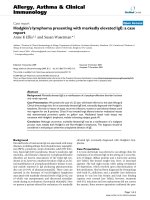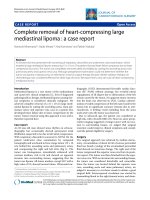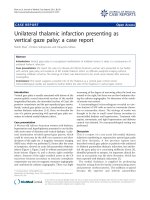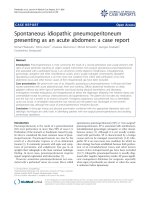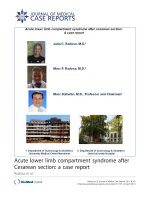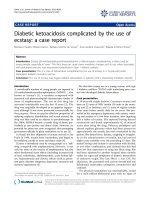Báo cáo y học: " Hodgkin’s lymphoma masquerading as vertebral osteomyelitis in a man with diabetes: a case report" pptx
Bạn đang xem bản rút gọn của tài liệu. Xem và tải ngay bản đầy đủ của tài liệu tại đây (613.71 KB, 5 trang )
CAS E REP O R T Open Access
Hodgkin’s lymphoma masquerading as vertebral
osteomyelitis in a man with diabetes:
a case report
Rachel A Bender Ignacio
1
, Anne Y Liu
2
, Aliyah R Sohani
3
, Jatin M Vyas
1,2*
Abstract
Introduction: Infection and malignancy often have common characteristics which render the differential diagnosis
for a prolonged fever difficult. Imagi ng and tissue biopsy are crucial in making a correct diagnosis, though
differentiating between chronic osteomyelitis and malignancy is not always straightforward as they possess many
overlapping features.
Case Presentation: A 52-year-old Caucasian man was treated with antibiotics for his diabetic foot infection after a
superficial culture showed Staphylococcus aureus. He had persistent fevers for several weeks and later developed
acute onset of back pain which was treated with several courses of antibiotics. Radiographic and pathological
findings were atypical, and a diagnosis of Hodgkin’s lymphoma was made 12 weeks later.
Conclusion: Clinicians should maintain a suspicion for Hodgkin’s lymphoma or other occu lt malignancy when
features of presumed osteomyelitis are atypical. Chronic vertebral osteomyelitis in particular often lacks features
common to acute infectious disease processes, and the chronic lymphocytic infiltrates seen on histopathology
have very similar features to Hodgkin’s lymphoma, highlighting a similar inflammatory microenvironment sustained
by both processes.
Introduction
Osteomyelitis of the spine is caused by direct instru-
mentation to the area, or contact with overlying soft-
tissue infection, or by hematogenous seeding of the
vertebrae. Risk factors for hematogenous vertebral
osteomyelitis (HVO) include prolonged bacteremia,
indwelling catheters, underlying diabetes, malignancy, or
other immunocompromised states [1]. Several other dis-
ease processes can a lso present with v ertebral lesions,
including atypical infections and primary or metastatic
malignancy. Hodgkin’s lymphoma (HL) can present with
asymptomatic mass lesions, B-symptoms or local symp-
toms in the location of the tumor bulk. It is most preva-
lent in young to middle-aged men. Lymphoma is not
commonly found in the bone at presentation, and B-cell
non-HLs are much more likely than HL to present i n
the bone. There is scant literature directly addressing
bony lesions in HL, especially in comparison to
infectious disease processes [2]. This case demonstrates
a patient who had the classic presentation and risk fac-
tors for HVO, but was ultimately found to have HL.
The diagnostic difficulties, histology of biopsy samples,
radiographic findings and di sease similarities are
discussed.
Case Presentation
A 52-year-old Caucasian man presented at an outside
hospital with three days of fevers and a swol len, purpu-
ric right foot. He had noted a necrotic-appearing ulcer
on the plantar surface of his fifth digit one week pre-
viously. His past history was remarkable for diabetes
mellitus type 2 (his last hemoglobin A1c [HbA1c] test
was 7.0%), his right great toe had been amputated sec-
ondary to infection in 2001; and he had a previous
cigarette use of 60 pack-years. He had worked for the
United States Forest Service, doing physical labor, often
working in wet boots and with close contact to the feces
of several species of forest animals. He had suffered a
tick bite 6 months previously.
* Correspondence:
1
Massachusetts General Hospital, Department of Medicine , Gray Building
Room 740, 55 Fruit Street, Boston, MA 02114, USA
Bender Ignacio et al. Journal of Medical Case Reports 2010, 4:102
/>JOURNAL OF MEDICAL
CASE REPORTS
© 2010 Ignacio et al; licensee BioMed Central Ltd. T his is an Open Access article distributed under the terms of the Creative Commons
Attribution License ( which permits unrestricted use, distribution, and reproduction in
any medium, provided the original work is properly cited.
On admission he was found to have a leukocytosis of
19,000 cells/mm
3
and mild normocytic anemia. The foot
ulcer was superficially cultured and grew methicillin-
sensitive Staphylococcus aureus (MSS A). While hospita-
lized, he experienced chills, ni ght sweats, nausea and
vomiting. He was discharged and given cefazolin and
metronidazole for a planned six-week course following
normalization of his leukocyte count and resolution of
systemic symptoms.
One month after discharge, he was re-admitted for
evaluation of recurrent sweats, chills and weakness. His
peripherally inserted central catheter (PICC) was
removed, and the tip was cultured but yielded no
growth. Surgical debridement of the fifth digit revealed
no gross purulence, and broth from the deep tissue
culture grew only Bacillus species. Vancomycin and
piperacillin-tazobactam were subst ituted for the cefazo-
lin a nd metronidazole regimen for a planned six weeks
duration of therapy.
One week after admission, he had a new onset of
lower back pain, prompting computed tomography (CT)
and MRI scans of the spine which revealed diffuse bony
lesions from T12 to L4. Microscopic analysis of a needle
biopsy of the L4 lesion showed a mixed inflammatory
infiltrate in a fibrotic background, interpreted as par-
tially treated osteomyelitis (Figure 1a). Core needle
biopsy of a right inguinal node demonstrated a dense
mixed inflammatory infiltrate with rare large degener-
ated cells of uncertain significance (Figure 1b). Gram
stain, acid-fast stain, and bacterial, mycobacterial and
fungal cultures were negative from both biopsies.
Antibiotics were discontinued and he was discharged.
Figure 1 Representative tissue samples at 400× magnification. The initial L4 vertebral core biopsy (a) shows marrow replacement by a
mixed inflammatory infiltrate consisting of small lymphocytes and some neutrophils in a fibrotic background. Rare large cells are present (arrow),
but diagnostic Reed-Sternberg (RS) cells are not identified. Trilineage hematopoietic marrow was present in other areas (not shown). The right
inguinal lymph node core biopsy (b) demonstrates a mixed inflammatory infiltrate consisting of small lymphocytes, histiocytes and eosinophils in
a fibrotic stroma. Rare large degenerated cells are also present (arrow) but are non-specific findings. The left anterior cervical lymph node
excisional biopsy (c) shows architectural effacement by a polymorphous infiltrate that includes scattered eosinophils, as well as diagnostic
multinucleated RS cells (blue arrow) and mononuclear variants (black arrows) that stain positively for CD30 by immunohistochemistry (d).
Bender Ignacio et al. Journal of Medical Case Reports 2010, 4:102
/>Page 2 of 5
He was re-admitted one week later with recurrent sys-
temic symptoms and a total leukocyte count of 20,000
cells/mm
3
. Vancomycin and imipenem-cilastatin were
started. Transesophageal echocardiogram revealed no
valvular vegetations. A bone scan revealed multiple
abnormal areas of uptake including the right f oot, sev-
eral ribs, scapula and both femurs. Blood cultures
throughou t these multiple hospitalizations did not
recover any pathogenic organisms.
Upon transfer to our facility, he note d a 7 kg weight
loss since the onset of symptoms, and he was fatigued
but ambulatory. Examination was significant for a single
<2 cm soft, mobile, tender lymph node in the left ante-
rior cervical chain and symmetric mild lymphadenopa-
thy in both axillae and the groin. His right foot ulcer
was well healed, though mild purpura and swelling
remained over the third through fifth digits. His spine
was not t ender to palpation. Laboratory testing revealed
a leukocyte co unt of 18,400 cells/mm
3
with 85% neutro-
phils and a platelet count of 404,000/mm
3
. C-reactive
protein (CRP) was 83 mg/L, erythrocyte sedimentation
rate (ESR) 106 mm/hour, and alkaline phosphatase 461
U/L. Laboratory evaluations for tick-borne and endem ic
fungal infections were all negative, as were an anti-
nuclear antibody (ANA) test, a rapid plasma regain
(RPR) test, and a human immunodeficiency virus
enzyme-linked immunosorbent assay (HIV ELISA).
Intradermal purified p rotein derivative (PPD) did not
elicit any induration. All antibiotics were discontinued,
and the patient remained febrile at 38.3-39.3°C nightly
with drenching sweats.
Ten sets of blood cultures were negative for bacteria,
fungi and mycobacteria. CT scans of the chest, abdomen
and pelvis revealed multiple small pulmonary nodules,
bilateral small pleural effusions, a small pericardial effu-
sion, two small calcified granulomas in the liver, and dif-
fuse cervical, mediastinal, iliac and inguinal adenopathy
(all ≤1.6 cm). A repeat MRI of the spine confirmed mul-
tiple areas of T1 hypointensity and T2 enhancement
throughout the cervical, thoracic and lumbar spine,
sparing the intervertebral disks and the cord (Fig ure 2).
Microscopic examination of a left cervical lymph node
excisional biopsy and staging posterior iliac crest bone
marrow biopsy revealed the presence of large atypical
cells consistent with Reed-Sternberg (RS) cells and
variants, and a diagnosis of Stage IV mixed-cellularity
classical HL was made (Figures 1c and 1d). Positron
emission tomography (PET)-CT was performed, display-
ing innumerable lesions in the axial spine and f luoro-
deoxyglucose (FDG)-avid nodes throughout innumerable
lymphatic chains. Increased uptake was especially noted
in the right lateral nasopharynx, without other solid
Figure 2 MRI of spine demonstrating multifocal hypointe nsities (arrows) sparing the int ervertebr al disks in T1-we ighted images (a).
The same lesions (arrows) appear hyperintense on T2-weighted images (b). No inflammation of the paraspinal muscles or abscess was identified.
Bender Ignacio et al. Journal of Medical Case Reports 2010, 4:102
/>Page 3 of 5
organ involvement. An escalated BE(A)COPP (bleomy-
cin, etoposide, doxorubicin, cyclophosphamide, vincris-
tine, procarbazine, and prednisone) regimen was
initiated. Because of hematologic complications, our
patient completed a course of modified Adriamycin
[doxorubicin], bleomycin, vinblastine and dacarbazi ne
(ABVD) chemotherapy and is in clinical and radio-
graphic remission (Figure 3).
Discussion
Though it is common f or malignancies a nd systemic
infections to have overlapping features, several aspects
of our case proved to be unique , ultimately delaying the
diagnosis of HL in our patient. A progression from what
became a chronic diabetic foot infection to vertebral
osteomyelitis would have been logic al. His underlying
diabetes, partially treated infection, and ultimately dis-
covered malignancy likewise placed him at significant
risk for hematogenously seeded vertebral osteomyelitis
[1]. Additionally, our patient denied ‘B symptoms’ prior
to the appearance of his ulcer, and his leukocytosis and
fevers temporarily resolved with initiation of each new
antibiotic regimen, making the diagnosis of malignancy
less likely. The presence of S. aureus in his necrotic dia-
betic foot ulcer concurrent with fe vers then directed
treatment of subsequent fevers exclusively towards per-
sistent bacterial infection for several weeks.
Patients diagnosed with non-HIV associated HL are
also diagnosed with twice as many infections in the 10
years prior to diagnosis as age-matched counterparts
without malignancy, not including the year preceding
diagnosis [3]. It is interesting to note that herpesviridae
infections are more p rominent in this population, pre-
sumably as a result of subtle immunological defects
from their malignancy.
S. aureus accounts for nearly half of all cases of HVO
and most commonly presents with back pain (89%) and
fever (>60%) [4]. Initial characteristics of CT and MRI
scans in our case raised suspicion for systemic involve-
ment, t hough both a vertebral fine needle aspirate and
core biopsy failed to confirm a diagnosis. Radiographic
features of osseous HL and HVO are often indistin-
guishable [2,5]. Evidence of spondylodiscitis, though
classic for infection, is not uniformly present in HVO,
and is often absent without involvement of contiguous
vertebrae. Imaging demonstrating paraspinal inflamma-
tion increases sensitivity and specificity for HVO, but
atypical organisms, such as mycobacteria, often lack
paraspinal inflammation and are also more likely to
demonstrate multi-level disease and skip lesions [6].
In HL, the most common site of bony involvement is
the spine, and multiple lesions at presentation are more
common than a solitary lesion [7]. Radiographic features
of our case made malignancy more likely, yet bone
involvement at presentation of HL is q uite uncommon,
with only 33 cases being identified by biopsy in the last
70 years at the Mayo Clinic, with the majority of cases
being primary osseous HL. When HL presented simulta-
neously in an osseous and a non-osseous site, 25% of
such cases were initially misdiagnosed as osteomyelitis
by histopathology [2]. Fine needle aspirates revealing
lymphoma cells have a nearly perfect diagnostic accu-
racy, while those containing non-specific findings of
osteomyelitis have insufficient positive or negative pre-
dictive value to confirm or exclude malignancy [8]. The
infrequently encoun tered, often degenerated, ma lignant
cells in our patient’s initial biopsies illustrate the need
for a high index of suspicion in such cases, and the
importance of procuring additional tissue via excisional
biopsy to confirm a diagnosis. The only site of solid
organ i nvolvement in our case proved to be within the
nasopharynx, which is found to be the site of the pri-
mary lesion in less than 1% of all HL cases.
The d iagnostic difficulties above highlight the similar
molecular pathways of chronic inflammations seen in
osteomyelitis and in HL. The microenvironment of HL
is composed of a heterogeneous group of cells including
T cells (CD4+ T cells being the most prominent cell
type), B cells, plasma cells, neutrophils, eosinophils and
Figure 3 The scout film of the positron emission tomography-
computed tomography (PET-CT) scan performed prior to this
first round of chemotherapy (a) demonstrates diffuse regions
of uptake involving multiple ribs, multiple vertebral bodies,
the pelvis, the sternum and the scapula. There is also increased
fluorodeoxyglucose (FDG) uptake in multiple bilateral lymph node
regions extending from the jugular, supraclavicular, mediastinal,
retroperitoneal, pelvic and inguinal regions, consistent with
Hodgkin’s lymphoma. There is increased FDG uptake in the
posterior and right lateral walls of the nasopharynx. About two
months after his first round of chemotherapy, a repeat PET-CT scan
(b) showed a marked interval decrease in the FDG-avid metastatic
burden.
Bender Ignacio et al. Journal of Medical Case Reports 2010, 4:102
/>Page 4 of 5
mast cells [9]. The prototypical RS cell represents only
about 1% of the cells in the HL tumor. The expression
of multiple cytokines by the RS cells appears to be criti-
cal in the development of the microenvironment and
these other cell types appear to be required to sustain
the viability of th e RS cells [10]. It i s interesting to note
that RS cells survive in immunocompetent, but not
immunodeficient , mice. RS c ells secrete interleukin-8
(IL-8) which serves as a chemoattractant for neutrophils,
and express multiple chemokine ligands including
CCL5, CCL17 and CCL22, which attract certain T-cell
subsets [9]. O steomyelitis is more frequent in pers ons
carrying the particular polymorphism of the Bax gene
promoter also linked to t he failure of these malignant
cells to undergo apoptosis [11]. Increased serum levels
of IL-6 found in patients with active osteomyelitis play a
causative role in decreased peri pheral blood neutrophil
apoptosis [12]. Both diseases produce a self-sustaining
microenvironment that is reliant on competent host
immunity to produ ce long-lived inflammatory cells gen-
erated by altered cell signaling.
Conclusion
Our case of Stage IV H L masquerading as osteomyel itis
highlights the inherent difficulties in differentiating bone
infection from malignant infiltration. Histopathological
confirmation of HL on ly came after an inconclusive
spinal biopsy and a lymph node core biopsy showing
only rare atypical cells. Clinicians should maintain a sus-
picion for HL or other occult malignancy in patients
with presumed osteomyelitis whose bony lesions appear
atypical when analyzed by radiography or pa thology, or
in their response to treatment.
Consent
Written informed consent was obtained from the patient
for publication of this case report and any accompanying
images. A copy of the written consent is available for
review by the Editor-in-Chief of this journal.
Acknowledgements
The authors thank Dr Jeremy Abramson for his thoughtful discussions. We
would also like to thank Chris Bambacus, Stephen Conley and David Ignacio
for their assistance with the figures.
Author details
1
Massachusetts General Hospital, Department of Medicine , Gray Building
Room 740, 55 Fruit Street, Boston, MA 02114, USA.
2
Massachusetts General
Hospital, Division of Infectious Disease, Grey-Jackson Room 504, 55 Fruit
Street, Boston, MA 02114, USA.
3
Massachusetts General Hospital, Department
of Pathology, Gray-Jackson Room 148-B, 55 Fruit Street, Boston, MA 02144,
USA.
Authors’ contributions
RABI researched the topic, organized the paper, and prepared the
radiographic images. AYL, RABI and JMV cared for the patient during his
hospital admission. RABI and ARS prepared the histological samples for
publication. All authors read and reviewed the final manuscript.
Competing interests
The authors declare that they have no competing interests.
Received: 5 June 2009 Accepted: 6 April 2010 Published: 6 April 2010
References
1. Isobe Z, Utsugi T, Ohyama Y, Miyazaki A, Ito H, Okuno S, Uchiyama T,
Ohno T, Arai M, Tomono S, Kurabayashi M: Recurrent pyogenic vertebral
osteomyelitis associated with type 2 diabetes mellitus. J Int Med Res
2001, 29:445-450.
2. Ostrowski ML, Inwards CY, Strickler JG, Witzig TE, Wenger DE, Unni KK:
Osseous Hodgkin disease. Cancer 1999, 85:1166-1178.
3. Newton R, Crouch S, Ansell P, Simpson J, Willett EV, Smith A, Burton C,
Jack A, Roman E: Hodgkin’s lymphoma and infection: findings from a UK
case-control study. Br J Cancer 2007, 97:1310-1314.
4. Sapico F, Montgomerie JZ: Vertebral osteomyelitis. Infect Dis Clin North Am
1990, 4:539-550.
5. Kayani I, Syed I, Saifuddin A, Green R, MacSweeney F: Vertebral
osteomyelitis without disc involvement. Clin Radiol 2004, 59:881-891.
6. Ledermann HP, Schweitzer ME, Morrison WB, Carrino JA: MR imaging
findings in spinal infections: rules or myths? Radiology 2003, 228:506-514.
7. Newcomer LN, Silverstein MB, Cadman EC, Farber LR, Bertino JR,
Prosnitz LR: Bone involvement in Hodgkin’s disease. Cancer 1982,
49:338-342.
8. Rezanko T, Sucu HK, Akkalp A, Tunakan M, Sari A, Minoglu M, Bolat B: Is it
possible to start the treatment based on immediate cytologic evaluation
of core needle biopsy of the spinal lesions? Diagn Cytopathol 2008,
36:478-484.
9. Kuppers R: The biology of Hodgkin’s lymphoma. Nat Rev Cancer 2009,
9:15-27.
10. Skinnider BF, Mak TW: The role of cytokines in classical Hodgkin
lymphoma. Blood 2002, 99:4283-4297.
11. Ocana MG, Valle-Garay E, Montes AH, Meana A, Carton JA, Fierer J,
Celada A, Asensi V: Bax gene G(-248)A promoter polymorphism is
associated with increased lifespan of the neutrophils of patients with
osteomyelitis. Genet Med 2007, 9:249-255.
12. Asensi V, Valle E, Meana A, Fierer J, Celada A, Alvarez V, Paz J, Coto E,
Carton JA, Maradona JA, Dieguez A, Sarasua J, Ocana MG, Arribas JM: In
vivo interleukin-6 protects neutrophils from apoptosis in osteomyelitis.
Infect Immun 2004, 72:3823-3828.
doi:10.1186/1752-1947-4-102
Cite this article as: Bender Ignacio et al.: Hodgkin’s lymphoma
masquerading as vertebral osteomyelitis in a man with diabetes: a case
report. Journal of Medical Case Reports 2010 4:102.
Submit your next manuscript to BioMed Central
and take full advantage of:
• Convenient online submission
• Thorough peer review
• No space constraints or color figure charges
• Immediate publication on acceptance
• Inclusion in PubMed, CAS, Scopus and Google Scholar
• Research which is freely available for redistribution
Submit your manuscript at
www.biomedcentral.com/submit
Bender Ignacio et al. Journal of Medical Case Reports 2010, 4:102
/>Page 5 of 5
